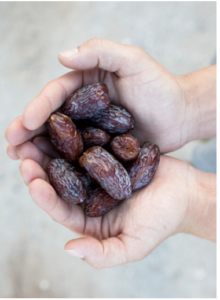Monocle, May 2017
Arizona’s arid landscape is home to a surprisingly plentiful crop. We meet the medjool-date technicians reaching for the skies in Yuma.
They were either smuggled out of the country or officially sanctioned; the versions vary depending on the source. What’s certain is this: after blight decimated the original crop of medjool dates in Morocco, seeds were dispatched to the US in the 1920s for testing under the stewardship of botanist Walter T Swingle. Isolated in Nevada, it would be two decades before they travelled to Bard, California, where they were nurtured and cajoled into bearing fruit fit for worldwide consumption. Swingle would never have dreamt that his experiment would develop into one of the largest global growers of medjool dates in the word – and in the most unlikely of settings.
North Africa and the Middle East may be the largest producers and consumers of dates in the world – they are particularly popular during Ramadan – but the bulk of it tends to be the deglet nour date, a mostly dried product that medjool farmers say has nothing on their own – none of that perfect skin separation and satisfying plumpness that helps the medjool sell at a premium.
“The medjool is the Cadillac of dates,” says Nels Rogers on his 55-hectare organic-date farm in Yuma County, just over the border from Bard in neighbouring Arizona. The owner of Martha’s Gardens says that people thought he was mad when he bought a strip of land on a sand dune in 1990 and announced that he would grow dates. “Everyone said that it would never work here, especially my uncle, who was a cotton farmer,” he adds. “Before he died he said that he couldn’t believe what I’d achieved.”
This southwestern nugget of the US – within striking distance of Mexico – can be unforgiving terrain. Yet it’s here on the sun-soaked mesa and down in the valley that the tall spines of date trees stretch towards the sky, an oasis in the middle of a cacti-studded desert. Some farmers are lucky enough to have access to a network of irrigation channels that sustains some agriculture. Others, like Rogers – who exports mainly to Australia – have had to pump water from an underground reservoir called an aquifer during what would be monsoon season (summer).
Date Gardens, the biggest player on the block. While Rogers has nearly 8,000 trees, Imperial has about 160,000 stretching in all directions. And while Rogers decided to go it alone, Imperial is part of 13-member Bard Valley Medjool Date Growers’ Association and co-owner of Datepac, the world’s largest packer of medjool dates. The mission of the association has been to set uniform branding, standards and pricing – and help push the product on the world.
“This is just in its infancy,” says Gus Nuñez, part of the family that runs Imperial Date Gardens. “There’s currently a market penetration of 5 or 6 per cent in the US.” Nuñez says that his father, who first started farming dates in the area in the mid-1960s, calls the date palm “a noble tree”. There’s certainly something regal about the way it fans out, providing shelter from the relentless sun. But date farming is far from easy. For one, left to nothing but the wind and pollination from bees it would produce little fruit. Instead flowers need to be taken from the male tree and then dried and crushed to extract the pollen. Then female plants need to be pollinated during a short window of just a few days in spring, either by hand using a pipette-type device or a blower (Imperial is currently testing a four-wheeled cannon that fires into trees). Add to the mix the date palm’s tireless desire to propagate, meaning offshoots constantly need to be removed, plus the work of cutting out thorns and excess flowers and you have an idea of the labour of love that’s involved.
Still, things are looking up for the date-growers on both sides of the California-Arizona border with smaller outfits such as Naked Dates in Wellton and Yuma’s Brocket Farms springing up. Arizona is already home to the largest acreage of medjool dates in the world – and is set to overtake Israel in terms of production in the next few years. And maybe, just maybe, they’ll crack the mass market. “I want to make this mainstream,” says Nuñez – but the date may be sooner than you think.
COMMENT
Produce unpacked
There are more than 3,000 varieties of dates and many claim that the medjool is the king of the crop. The Bard Valley Medjool Date Growers Association in Arizona and California has a collective area of about 3,000 hectares of medjool-date groves with output increasing about 20 per cent year on year. Exports are about 40 per cent of the business, with sales to Australia, the UK, Scandinavia and Germany. About 7.5 million tonnes of dates are produced worldwide, with Egypt, Iran and Saudi Arabia leading the way in production, while Pakistan is the biggest exporter. Israel and the US concentrate on the higher-end medjool instead of variants such as the common deglet nour.
